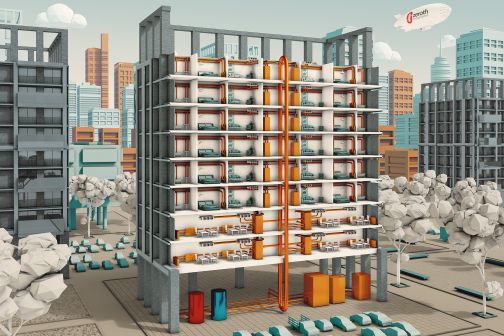
What are the 12 key factors that could shape a successful and sustainable UK heat pump market?

The Climate Change Committee (CCC) illustrates the importance of heat pumps and the urgent need for action in tackling accelerating climate change. The CCC states that 19 million heat pumps need to be installed (with at least a quarter being part of a hybrid system) by 2035. It is anticipated that this interim measure could lead to the realisation of the 2050 net-zero carbon target.
The number of projects that incorporate split system heat pumps and monobloc heat pump systems in the UK is rising, but there are still barriers to the widespread application of innovative heat pump technologies. From changes in the specification process and supply chain through to electrical grid capacity, these challenges can all be overcome with the right level of expertise and support.
In this article, we are examining 12 key factors that should be considered if we are to create a sustainable and successful heat pump market in the UK and drive the energy decarbonisation process.
- Availability of financial incentives for all types of heat pump technology, including traditional solutions, in-apartment heat pump networks, hot water heat pumps and other hybrid systems, could encourage specification of the right solutions for each project. This could alleviate the energy cost imbalance and support should be available for all development types to maximise the uptake of low carbon technologies.
- The industry would benefit from the support of interim solutions in buildings where full heat pump installation is financially or technically challenging, or not desired. In-apartment hot water heat pumps can help developers achieve on-site renewable contributions and reduce energy bills for the end user. This can occur when hot water heat pumps are paired with efficient direct acting panel heater and high heat retention storage heaters. The added benefit is the availability of funding for additional insulation works in line with the agreed industry ‘fabric first’ approach. This enables simpler transmission to low carbon technology at a later stage and a decrease of installations using natural gas heating which may be more expensive to retrofit.
- Shortening the period for specification of technologies that may be considered non-compliant by the updated Part L, could significantly lower the risks of unexpected and more expensive retrofit challenges in the future. This would put the industry on the front foot and create a more stable heat pump market.
- To help instill confidence in the market a clear long-term trajectory on carbon reduction and energy efficiency targets are needed. Confirming the path for the support of electrical infrastructure could also encourage wider investment and support for projects that are looking to electrify and future proof.
- Providing the industry with the freedom to use the most suitable technology, instead of regulating technologies, can encourage innovation. Creating target focused regulatory frameworks could also stimulate specification of heat pump and hybrid technologies and innovative solutions, such as hot water heat pumps and in-apartment heat pumps.
- Close cooperation among UK manufacturers and contractors will become especially important if the industry is to be successful in dealing with the challenge of embedded carbon reduction through the correct manufacture, design and application of solutions to buildings.
- There is currently a skills gap that slows down an uptake of low carbon technology and in turn affects market growth. By ensuring the uptake of heat pump technology is matched with enough skilled designers and installers, a larger number of low carbon projects could be rolled out. Hybrid solutions that combine gas and hot water heat pumps would be the ideal starting point to provide a platform for gradual, barrier-free re-training as the installation process is typically less involved and based on existing skillsets.
- Specifying flexible energy storage alongside heat pump solutions would help to prevent the challenges that a steep heat pump uptake may pose on local energy requirements and the grid. Designing systems with high heat retention storage heaters or hot water buffer tanks would create energy stores in homes, thus reducing the demand on the grid and energy costs through correct, smart application of tariffs. Flexible energy storage is significant for the support of fast low carbon technology rollout.
- Electrification should not be achieved entirely at the cost of the house owner or tenant, as this may affect housing desirability and affordability. Highly efficient systems such as ambient networks with in-apartment heat pumps can help design out overheating in buildings and maximise energy efficiency by preventing heat distribution losses. This could help address the challenges of energy costs for end users. The electrification of heating could be further progressed by tackling regulations around fuel poverty and market mechanisms for energy costs, ensuring that new and exiting properties are electrified, or can be in the future, at reasonable cost to the owner and occupier.
- Smart technology and energy storage have already captured public interest, resulting in increased demand for this type of technology in both buy and rental properties. Increasing public awareness of heat pumps and improving their perception with an educational campaign, which focused on a variety of low-carbon technologies, may stimulate heat pump demand. Just like with EV’s if the battle for consumer adoption can be won, the rollout will be far simpler and cheaper for government.
- With temperatures rising globally, the UK is dealing with the new challenge of overheating. This can be exacerbated in new developments with lower permeability where the heat that escapes from HVAC systems and other sources gets trapped in corridors and communal areas. Also, in buildings where passive cooling measures aren’t sufficient to deliver desired occupant comfort level, heat pumps can often provide effective comfort cooling. Heat pump-based systems can even deliver heating and comfort cooling for apartment buildings through the same infrastructure. By specifying heat pumps to deliver comfort cooling, not only is a sustainable heat pump market created, but the technology could help with any overcome overheating challenges in UK homes. It would also mean no additional high carbon costs of air-conditioning units, and improved consumer opinion of the new technology over the previous, fossil fuel options.
- Supporting future proofing in building design by allowing for values beyond the new minimum flow rate for wet systems would make any retrofit simpler and less resource intensive in the future, as specified emitters have the scope to deal with future low carbon alternative plant.

Can specification of heat pump technology help create a prime environment for a flexible energy grid?
New technologies based on heat pump solutions, like highly efficient ambient loop The Zeroth Energy System or Edel Hot Water Heat Pump, are designed with input from across the industry to help drive carbon reduction and maximise the energy efficiency of our buildings. Along with these two key drivers, the technologies were developed with a focus on the challenges of modern construction, which include; usable space, speed, cost of installation, user comfort, and service demand.
The Zeroth Energy System can supply heating, comfort cooling and hot water via a communal network that operates at ambient temperatures thus significantly reducing the chance of overheating in buildings, and maximising energy efficiency. The system also allows for flexible emitter and control specification in buildings, enabling end user target specification simpler and more cost effective.
The Edel Hot Water Heat Pump was designed to address the energy efficiency of hot water delivery in residential buildings. Hot water delivery is often the dominant energy load, with a resulting high carbon footprint. When paired with efficient direct acting panel heating or high heat retention storage heating, the solution can achieve compliance and reduce energy bills in new and existing homes.
Whether we are considering the interim Part L and Part F that propose a 31% carbon reduction target by 2025, or the Future Homes Standard that sets a target of 70-80%, there is a growing need for carbon reducing solutions. Innovative low carbon heat pump technologies such as the Zeroth Energy System or the Edel Hot Water Heat Pump, can pave the way to low carbon heat delivery today. These technologies can be employed in both new projects and retrofit without the need for overreaching budgets or lengthy specialist installations.
The objectives and limitations of each project are vastly different, but heat pump technology can be deployed in any type and size of building across the sectors. For advice on the Zeroth Energy System, the Edel Hot Water Heat Pump, or our vast range of commercial heat pumps and complementary technology, contact our team of industry experts.








